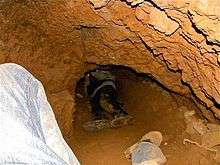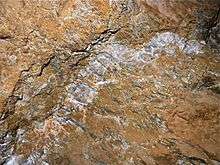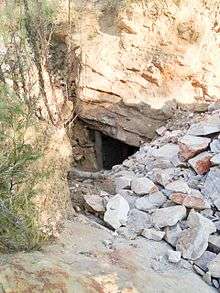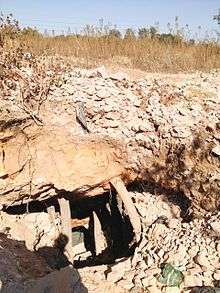Artisanal mining
Artisanal and Small Scale Mining (ASM) is emerging as an important socio-economic sector for the rural poor in many developing nations. An artisanal miner or small-scale miner is, in effect, a subsistence miner. They are not officially employed by a mining company, but rather work independently, mining or panning for gold using their own resources. Small-scale mining includes enterprises or individuals that employ workers for mining, but generally working with hand tools.
Artisanal miners often undertake the activity of mining seasonally – for example crops are planted in the rainy season, and mining is pursued in the dry season. However, they also frequently travel to mining areas and work year round.
An estimated 13 - 20 million men, women, and children from over 50 developing countries are directly engaged in the artisanal mining sector.[1]
Issues in Artisanal Mining
Artisanal mining can include activities as simple as panning for gold in rivers, to as complex as development of underground workings and small-scale processing plants. In any of these circumstances, issues can stem from difficulties in achieving regulatory oversight of a large number of small operations (including issues such as security of land tenure for artisanal miners, to enforcement of environment, safety standards, and labour standards).
As a result, child labour and a large number of fatal accidents have been reported in artisanal mines (especially coal mines, gold mines, stone mines).[2][3][4] To improve the situation of small-scale miners, organising them in cooperatives and certifying gold may be helpful, write the scientists Pedro Morazán and Marie Müller in the magazine D+C Development and Cooperation.
Globally, artisanal mining contributes up to 12% or 330 tonnes of annual gold production.[5] This gold input is equally a significant contribution to both the international gold industry and the economy for a given community. A steady rise in the price of gold from US$274.45/oz at the start of 2002 to US$1229.88/oz in May 2010[6] appears to be reflected as an increasing number of miners undertaking this occupation.
Environmental Issues
Due to the inherent digging of soil and sluicing involved in artisanal mining, water siltation, erosion, and soil degradation can be an issue in rivers used for mining.[7] Rivers are also commonly diverted as a way to access mineral rich riverbeds.[8] The digging of mines can also dig up and spread harmful materials, such as lead, that are located within the soil.[9]
The conservation of forests is also a great concern as many artisanal mining operations take place in and around forests that are home to vast amounts of biodiversity. One assessment indicates that almost three-quarters of active mining and exploratory sites overlap with areas of high conservation value and high watershed stress.[10] It has also been reported that some mining operations also work within environmental protected areas.[11] Artisanal mining operations often cut down trees to clear space for their camps, and it is common for miners to hunt, fish, and collect other forest resources for food and medicine, or as a way to supplement their income.[11]
Mercury and other dangerous chemicals, such as cyanide, are commonly used in artisanal gold mining. Mercury is used during the amalgamation process as a cheap way to collect small gold particles from sediment. Once mercury and gold are combined to create amalgam, the amalgam is typically burned with a blowtorch or over an open flame to separate the mercury from the gold. Since gold mines are almost always set up near rivers, often excess chemicals are distributed directly into waterways. Once it becomes imbedded in soil or water, mercury becomes methylmercury that can easily accumulate in fish; which not only harms the fish but all other animals, including humans, who eat fish.[12] According to the U.S. Environmental Protection Agency, the observed effects on animals exposed to high levels of methylmercury include mortality, reduced fertility, slower growth rates, and abnormal behavior that affects survival.[13]
Violence
Artisanal mining has attracted a large number of Chinese migrant workers to Africa.[14][15] In 2013, widespread conflict and violence between illegal Chinese artisanal mine workers and Ghanaian natives were reported.[16][17] Ghana officials claimed tens of thousands of Chinese immigrants were working in illegal artisanal gold mines, damaging land, polluting drinking water, and destroying agricultural lands. This triggered violence and armed attacks between Chinese groups and local Ghanaian villagers, causing widespread unrest and deaths. By July 2013, Ghana had deported over 4,000 Chinese citizens working illegally in artisanal mines.[18]
Opportunities in Artisanal Mining
ASGM, if properly regulated, has the capacity to lift people out of poverty, improve health and environmental conditions, and create better economic conditions for entire regions. The sector provides effective poverty relief by providing jobs, ensuring profits for small producers, and transferring wealth from rich to poor countries. Many poor populations in rural areas of the developing world mainly participate in low productivity employment in the agricultural and services sectors. ASM supplements these livelihoods and creates jobs in some of the poorest places in the world.
Although there are large industrial mines worldwide, artisanal mines employ about ten times as many people, typically workers who are not eligible for employment in industrial mining due to a lack of formal education and experience. Furthermore, small miners’ earnings tend to be spent locally or sent as remittances to other poor communities, supporting sustainable economic growth in local communities. Bringing ASGM into the formal economy through legalization benefits governments in that they reduce illicit financial transactions, collect taxes, and often see a subsequent reduction in crime in these regions. ASGM is recognized by the world’s major development organizations such as the UN, World Bank, and Global Environment Facility to have the potential to be a major driver for rural development, improving lives in large, rural areas.
Approaches to Supporting and Formalizing Artisanal Mining
Although there are many widespread problems with ASGM, through various levels of support the ASGM sector can be improved and its potential harnessed. For example, Global Affairs Canada is financing projects to help miners obtain better technology and to employ better environmental and social practices. This equipment and accompanying training decreases and ultimately eliminates the use of mercury, and often increases the gold yield for miners.
The Artisanal Gold Council (AGC)
The Artisanal Gold Council (AGC), based in Victoria British Columbia, works with industry stakeholders to drive rural development in many developing countries. Part of AGC’s focus is to train miners to adopt more responsible, environmentally friendly methods of mining and gold processing. By focusing on chemical-free methodologies that forego the use of mercury and other toxic chemicals, the miners are able to work in a safer and healthier environment, and responsibly produce gold, generating positive, long-term benefits to their health, economy and environment. The AGC is a not-for-profit dedicated to improving the opportunities, environment, and health of the millions of people involved in Artisanal and Small-Scale Gold Mining in the developing world. Through doing so the AGC aims to improve the health and safety of workers as well as decrease the environmental impact of the global gold sector. Current projects include GAC (Global Affairs Canada) funded work in both Peru and Indonesia, and help to various countries in fulfilling their obligations under the Minamata Convention by working with them to develop National Action Plans (NAPs) to reduce and eliminate mercury use in artisanal and small scale mining.
For more information see www.artisanalgold.org
The Alliance for Responsible Mining (ARM)
The Alliance for Responsible Mining (ARM) is an independent, mission-driven initiative that supports artisanal and small-scale (ASM) miners globally. Established in 2004, the organization’s mission is to enhance social and economic wellbeing, strengthen environmental protection and establish fair governance in ASM communities by formalizing the ASM sector. To achieve its mission, ARM has created an exceptional set of social and environmental standards known as the Fairmined certification. ARM offers extensive and continuous support and training to ASM communities to help them reach the standards, achieve the Fairmined certification and invest in community development. Furthermore, ARM serves as an intermediary for ASM communities, which gives them the opportunity to respond to international markets demanding ethical metals and jewelry. Since 2004, ARM has facilitated the positive transformation of multiple ASM communities in Latin America and is currently expanding its efforts to Africa and Asia.
For more information, see: www.communitymining.org/arm
Collaborative group on Artisanal and Small-Scale Mining (CASM)
CASM is a global networking and coordination facility with a stated mission to “to reduce poverty by improving the environmental, social and economic performance of artisanal and small-scale mining in developing countries.” CASM is currently chaired by the UK's Department for International Development and is housed at the World Bank headquarters in Washington, D.C.
Resourced by a multi-donor trust fund, CASM currently receives its core funding from the UK and the World Bank, supplemented by program support from Japan, amongst others, Canada, France and the US. Several companies, trade associations and charitable funds, such as Tiffany & Co Foundation, also contribute finances to CASM's work program. CASM funding has leveraged significant additional funding for work in the ASM sector.[19]
In 2008, CASM produced a report on Mineral Certification.[20] This report discussed the opportunity of using certification of origin and certification of ethical quality to stimulate sustainable development in artisanal mining communities.
International Program on the Elimination of Child Labour (IPEC)
IPEC, a program of the ILO, includes a sector of activity in "Mining and Quarrying". It notes that child labour "can still be seen in small-scale mines of Asia, Africa, Latin America, and even parts of Europe".[21] The IPEC approach focuses particularly on the development of a solid knowledge base and assessment, and working with partners for delivery of programs.
ICMM "Working Together" - How large-scale mining can engage with artisanal and small-scale miners
A significant issue in artisanal and small-scale arises when larger mining companies gain rights to develop deposits that are currently worked by artisanal minings. The International Council on Mining and Metals (ICMM) has produced a guidance note for companies engaging with the artisanal and small-scale mining (ASM) sector. As is noted in the introduction to this document "The fact that much of ASM activity occurs outside regulatory frameworks – whether illegal or not – can also present significant challenges for companies and regulators. There can be significant tension between ASM miners and their own governments – with companies caught in the middle."[22]
The guidance document, which is put forward as a pilot[23] was produced in partnership with Communities and Small-Scale Mining (CASM), the International Finance Corporation’s Oil, Gas, and Mining Sustainable Community Development Fund (IFC CommDev) and ICMM.
Country Specific - Ghana
In Ghana, the regulation of artisanal gold mining is set forth in the Small-Scale Gold Mining Law, 1989 (PNDCL 218). The Precious Minerals Marketing Corporation Law, 1989 (PNDCL 219), set up the Precious Minerals Marketing Corporation (PMMC) to promote the development of small-scale gold and diamond mining in Ghana and to purchase the output of such mining, either directly or through licensed buyers.
Country Specific - Peru
Peru's government passed legislation in 2002 which aimed to formalise and promote artisanal gold mining activity, seen as a "great source of employment and collatoral benefits". Despite this legislative commitment, the complexities involved in formalisation efforts have seen subsequent governments shy away from such initiatives. Authorities charged with implementing the legislation and regulating the activity, lack the finance and personnel necessary to carry out such tasks effectively.[24] La Rinconada, Peru, highest elevation human habitation in the world, in the Andes on the border with Bolivia, is one site of extensive artisanal mining.[25]
Country Specific - South Africa
As the price of gold grew on international markets, formal large-scale mining in South Africa shed jobs, while labour unrest and strikes led to increasing layoffs of mine workers on the large mines. South Africa has some of deepest and largest gold mines in the world, with some of the largest deposits of gold, platinum, diamonds and other precious metals, precious stones and dimension stone. Gold deposits, in particular began to be exploited by artisanal miners, and 'illegal miners', known as zamazama (isiZulu, lit. 'try-try', meaning 'try and try again' or 'don't give up').
According to the Mineral and Petroleum Resources Development Act of 2002, only large, fully registered, capital intensive industry may prospect for, mine and process minerals. The South African government is the legal owner or 'custodian' of all underground resources irrespective of land rights or title on the land surface. While any small scale and artisanal miners are, by definition, illegal, all natural resources covered by the act are deemed to be "the common heritage of all the people of South Africa". This provision gives many illegal miners the justification they need, and that they feel is important, to mine these resources for their own account, regardless of the other provisions of the Act.
Only some minerals, such as gold and diamonds, can be mined in an artisanal fashion. Gold and diamonds exist in shallow surface deposits in South Africa, as well as in deep deposits. For instance, Tau Tona gold mine to the west of Johannesburg, extends 4 km underground, but at the same time, artisanal miners are still exploiting near-surface deposits ranging from only a few meters to 100 m underground in the same area.
Outside of the large formal mines, artisanal mining takes two forms. The 'illegal miners', or zamazama. The overall pool of miners, that is, of men who identify as miners and wish to work in mining, includes many who are partially employed, employed by labour brokers, outsourced workers, and other part-time or unemployed miners who often live in informal settlements around the large mines.
Artisanal miners are of three kinds: 'illegal' miners, artisanal miners, and peripheral or part-time miners who may shift back and forth from between formal, illegal, and artisanal mining work.
Artisanal miners who gain access to formal mines through disused shafts and adits are called 'illegal miners' or zamazama. They compete with formerly employed legal mine labour in large underground mines for gold. The zamazama may live underground for many weeks, while collecting sufficient quantities of high grade ore for further processing. They are often miners who have been trained in formal mining techniques, but then laid off. They resort to illegal mining in order to continue to utilise their skills. Their social networks with other formally employed miners help them to obtain access to underground mine workings.
Other miners are properly artisanal, opening adits and driving shafts and tunnels using hand tools such as hammers, chisels and spades. They train each other and typically have little or no formal mining experience.




The nature of gold deposits helps to determine the type of artisanal mining. On the Witwatersrand reef, gold is found in the form of very fine particles in hard-rock sedimentary conglomerate rock in steeply inclined deposits. 350 km to the west of Johannesburg and the Witwatersrand reef (the ridge that contains the gold), the mines around Barberton contain visible nugget gold in quartz veins, in addition to fine particles, that are embedded in metamorphosed late Archaean age rocks dating to 3.2-3.4 billion years ago. These different formation require different artisanal and formal mining methods, with different social and economic structures.
For instance, the deep mines of Johannesburg are capital intensive and deep, while the associated artisanal mining is shallow and relatively unprofitable. Artisanal miners usually operate as teams that carry the process through from underground mining and sorting the ore, to production of the finished gold for sale. Artisanal mining in the Barberton region produces relatively large nuggets in reasonably profitable mining ventures. Formal mines, such as Agnes, Fairview, Consort, and Barbrook, are relative small, and artisanal mining is growing in the region.
Since artisanal mining is illegal in South Africa, it is difficult to estimate its economic value. In gold bearing regions such as Roodeport and Barberton, specialised settlements and organisations have emerged recently (since 2007).
Artisanal mining in South Africa probably has a long history, but this has not been documented. For Zimbabwe, Roger Summers has mapped extensive pre-colonial mines, prospecting trenches, and early processing sites, but this has so far not been done for South Africa.
Violence is a constant problem in the artisanal mining sector. This is often caused by conflict between miners and police and private security personnel, and between different groups of miners competing for resources. However, there is also a remarkable degree of mutual respect among the miners, especially in the face of the dangers presented by conflict above ground, and the danger of work underground. Typically, artisanal miners are young males, but there are occasional female underground workers. Women and children are often involved in sorting and pulverising the ore above ground, and in transporting food, materials, and other logistic support.
Gold ore is processed informally using simple technologies. Ore is first crushed by hand on open rock surface and hammerstones. This work is often done by women and children. The pulverised ore is concentrated using visual sorting, sieving, gold panning, and by washing on riffle tables made of plastic sheets on heaps of sand. Final gold extraction is accomplished using mercury amalgamation. Mercury is typically burned off using an oxy-gas torch. The gold is sold to local agents, or may be exported directly to major markets for raw gold including India, China, Israel and Lebanon. Gold is also taken across borders into Zimbabwe and Botswana where legislation makes it easier to sell the gold to small refineries and small mining operations, where it may be incorporated into their own output for reporting purposes.
Artisanal mining in South Africa appears to be increasing despite the legal and practical difficulties.
See also
| Wikimedia Commons has media related to Artisanal mining. |
References
- ↑ Advancing the EITI in the Mining Sector: Implementation Issues By Sefton Darby and Kristian Lempa, produced by the World Bank’s Oil, Gas and Mining Policy and Operations Unit (COCPO) with support from the EITI Multi-Donor Trust Fund (undated, post 2006)
- ↑ Child labour present in many artisanal mines Archived April 18, 2013, at the Wayback Machine.
- ↑ Child labour Archived April 29, 2014, at the Wayback Machine.
- ↑ Child labour occurring in gold and stone mines
- ↑ CASM Web Site
- ↑ http://goldprice.org/live-gold-price.html
- ↑ http://pubs.iied.org/pdfs/G00723.pdf
- ↑ "Archived copy" (PDF). Archived from the original (PDF) on 2016-03-04. Retrieved 2013-06-13.
- ↑ http://www.bbc.co.uk/news/10254110
- ↑ http://awsassets.panda.org/downloads/congobasinmining.pdf
- 1 2 Ingram, V., et al. (2011). “Where artisanal mines and forest meet: Socio-economic and environmental impacts in the Congo Basin.” Natural Resources Forum: A United Nations Sustainable Development Journal. 35(4), 304-320.
- ↑ Spiegel, S. (2009). “Socioeconomic dimensions of mercury pollution abatement: Engaging artisanal mining communities in Sub-Saharan Africa.” Ecological Economics. 68(12), 3072-3083.
- ↑ http://www.epa.gov/hg/eco.htm
- ↑ Chinese Mining Industry Contributes to Abuses in Democratic Republic of the Congo
- ↑ The price of gold: Chinese mining in Ghana
- ↑ Chinese gold miners’ hope for riches shattered by Ghana crackdown
- ↑ Ghana Arrests Chinese in Gold Mines
- ↑ Ghana deports thousands in crackdown on illegal Chinese goldminers
- ↑ CASM web site
- ↑ CERTIFICATION AND ARTISANAL AND SMALL-SCALE MINING: an Emerging Opportunity for Sustainable Development April 2008
- ↑ ILO Website
- ↑ "Working Together", published by ICMM, February 2008
- ↑ News 01.02.10 Archived May 7, 2010, at the Wayback Machine.
- ↑ Peru Support Group 25.09.12
- ↑ William Finnegan (April 20, 2015). "Tears of the Sun The gold rush at the top of the world." (The New Yorker). Retrieved April 13, 2015.
Many mining towns are company towns. La Rinconada is the opposite. Nearly all the mines and miners here are “informal,” a term that critics consider a euphemism for illegal. Ilasaca prefers “artisanal.” The mines, whatever you call them, are small, numerous, unregulated, and, as a rule, grossly unsafe. Most don’t pay salaries, let alone benefits, but run on an ancient labor system called cachorreo. This system is usually described as thirty days of unpaid work followed by a single frantic day in which workers get to keep whatever gold they can haul out for themselves.